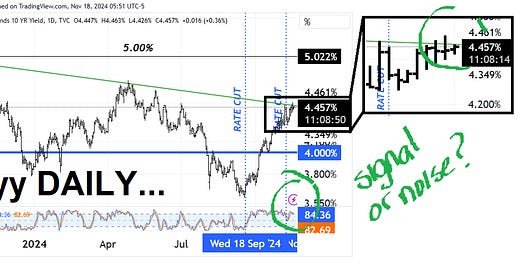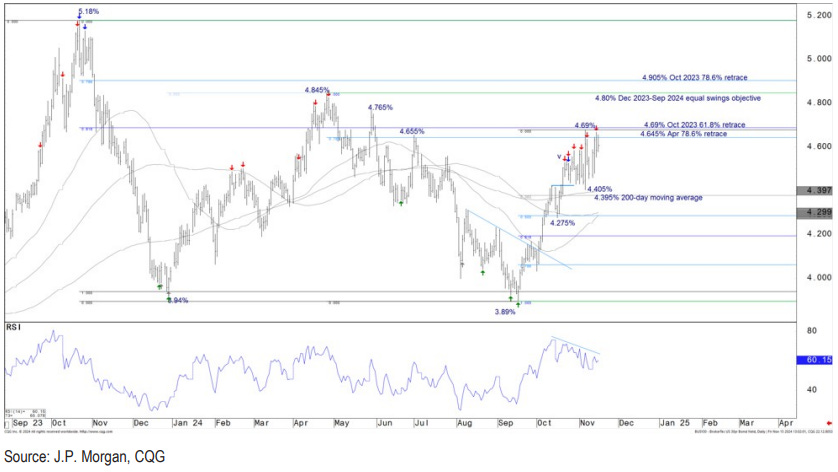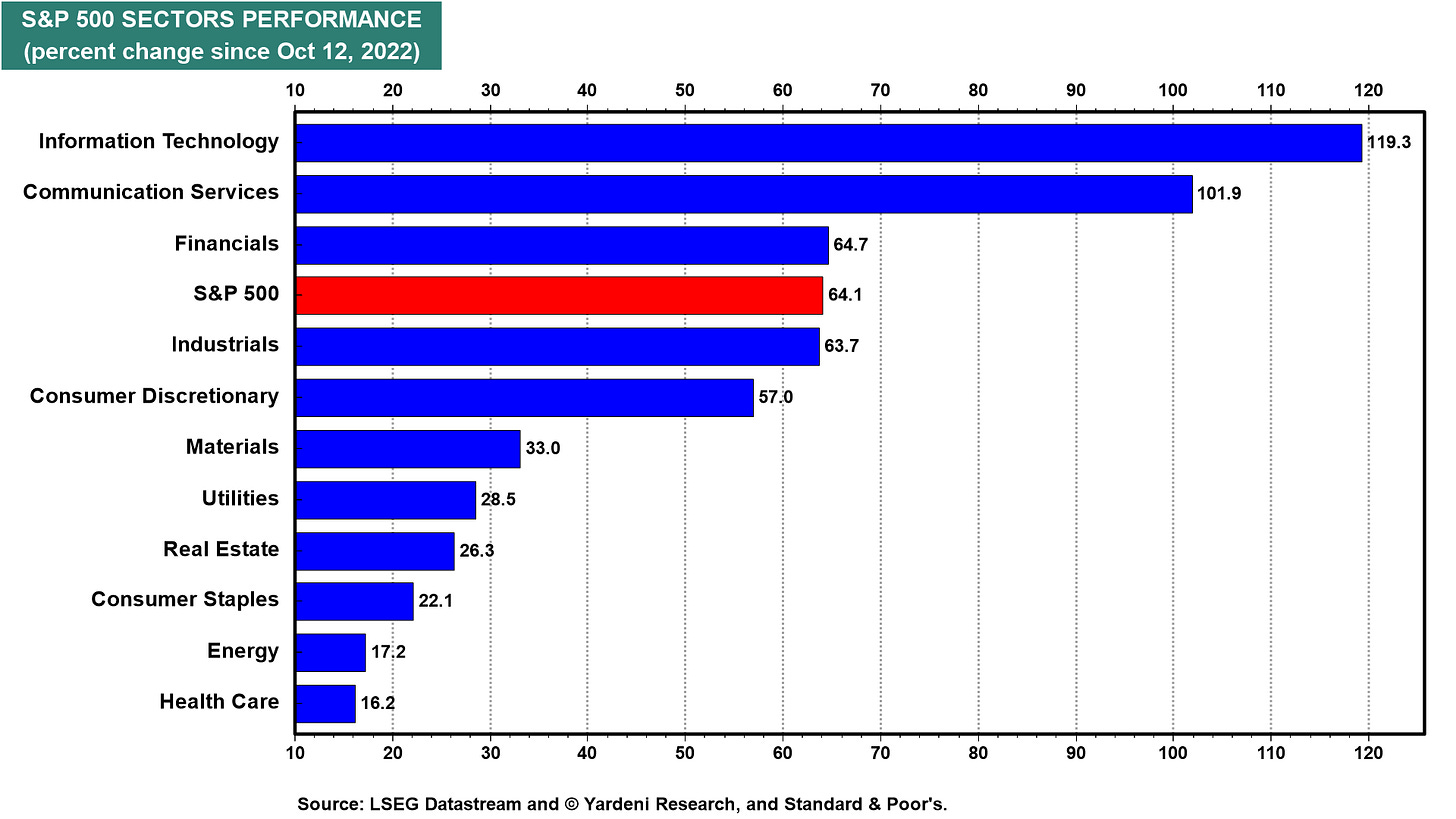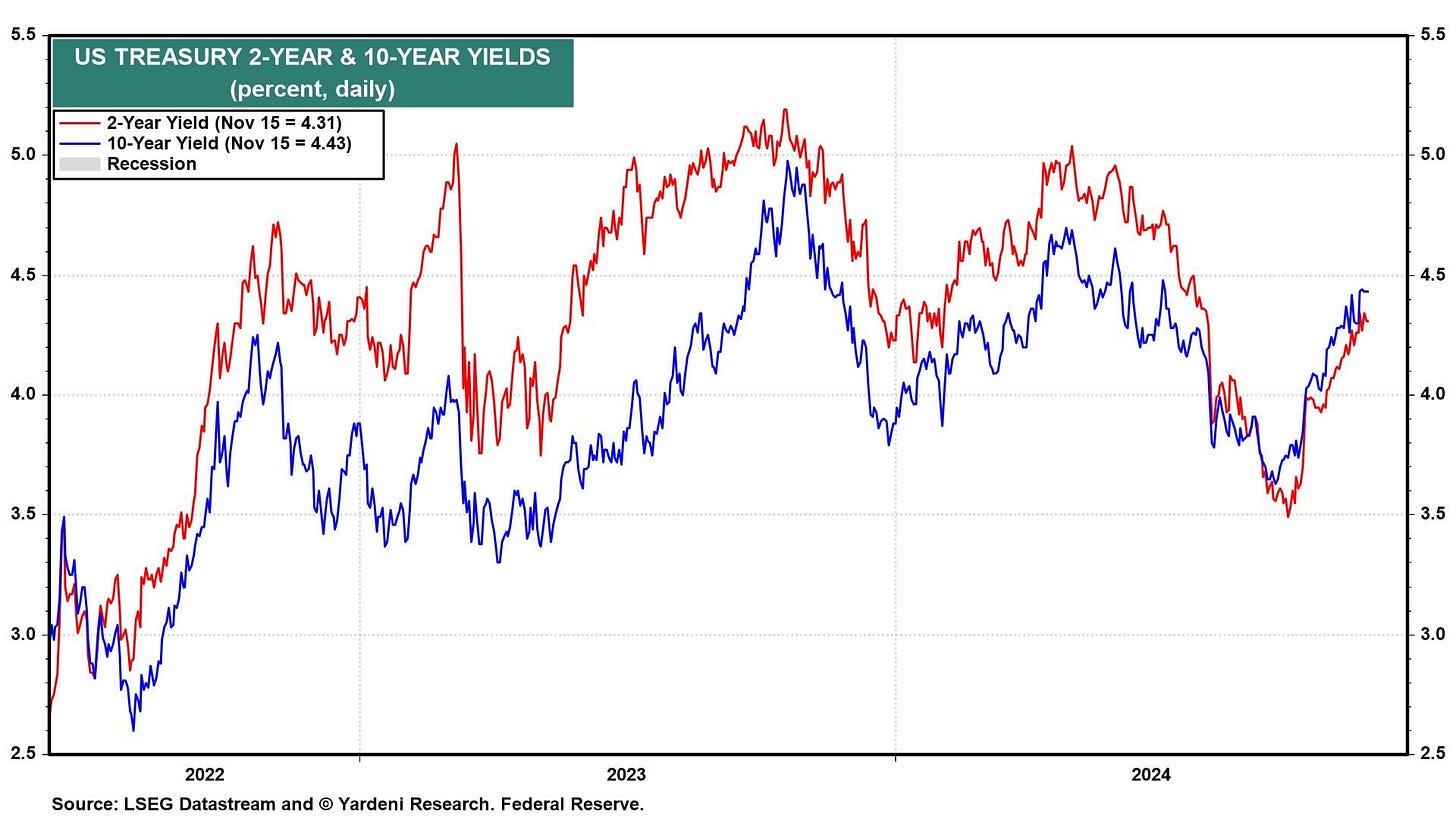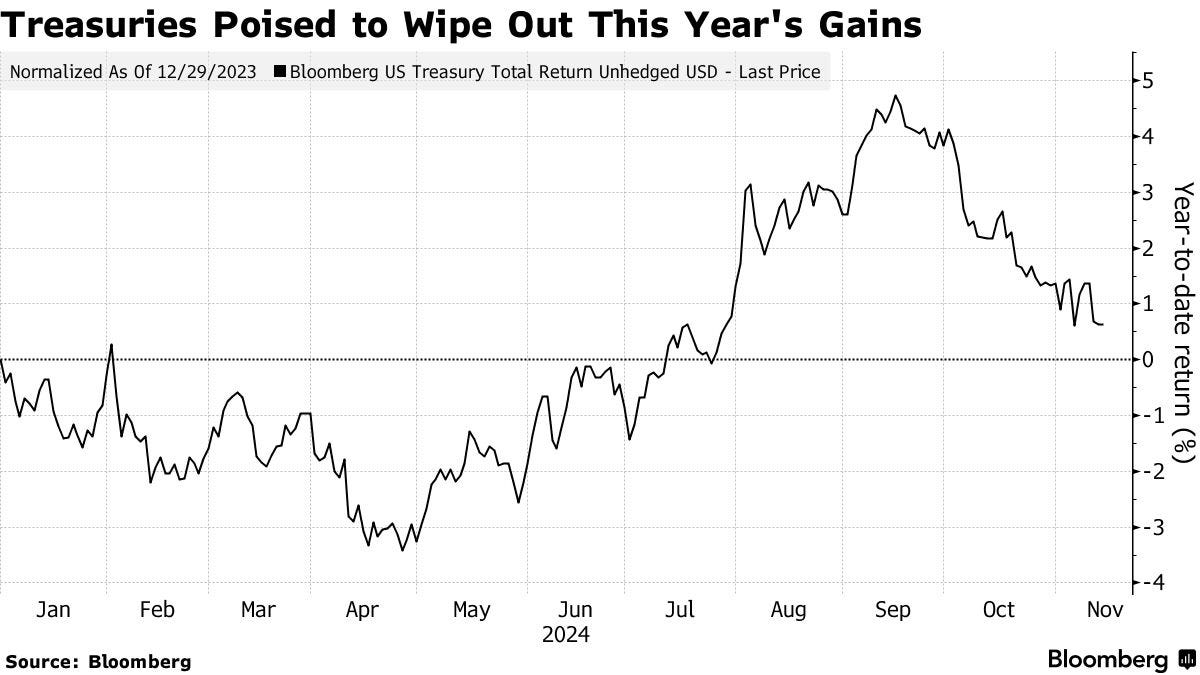while WE slept: USTs cheapening ('consolidation mode') o/n; USTs 2024 'gains dwindle' (Santa Pause?); 2025 dart-throwing contest continues (#2025 -MS)
Good morning …
As the week begins and the end of the year ritual of throwing darts at the 2025 Narrative Dartboard picks up, in earnest (DB over weekend and some more from Global Wall just below) AND as I will be travelling tomorrow in / out of NYC, I hope to leave you with plenty to contemplate …
… here is a snapshot OF USTs as of 647a:
… and for some MORE of the news you might be able to use…
IGMs Press Picks: November 18 2024
NEWSQUAWK: US Market Open: US futures are mixed, Bonds edge lower whilst XAU gains; ECB Lagarde due … USTs are marginally lower whilst Bunds extend losses and slips below 132.00 … Minor losses for the Dec'24 UST with prices currently in consolidation mode after the election. The Dec'24 UST contract is currently within Friday's 108.30-109.23+ range; the lower bound of which was a contract low. The US yield curve is marginally bull-steepening with the 2s10s wider by around 14bps.
PiQ Overnight News Roundup: Nov 18, 2024
… US 10yr Treasury note “appears cheap,” but the valuation is still not compelling enough to present a buying opportunity, JPMorgan strategists led by Jay Barry wrote in a note last week. They “prefer to be patient in fading these recent moves.” (BBG)
Opening Bell Daily: Trump Trade unwinds. The stock market has pulled back to pre-election levels. The Trump Trade has taken a back seat to Fed uncertainty and inflation risks.
Reuters Morning Bid: Bruised Wall Street keeps wary eye on Nvidia
Finviz (for everything else I might have overlooked …)
Moving from some of the news to some of THE VIEWS you might be able to use… here’s SOME of what Global Wall St is sayin’ … First UP … France weighing in …
BNP: Sunday Tea with BNPP: US back on top
KEY MESSAGES
We see room for further USD outperformance and remain long versus the EUR, THB and JPY.
We think Powell’s speech last week creates substantial risk of a December skip, though only if realized economic data line up more firmly.
We remain long 5y US breakevens but acknowledge the risk of lower oil prices.
… Powell lowers bar to a skip: Fed Chair Jerome Powell's speech last Thursday suggests that there are more rate cuts coming – as there was still a present-tense mention of "moving policy over time to a more neutral setting." But he also said the Fed may do this at a slower pace. We think this creates a substantial risk that it will leave policy unchanged at the December meeting. In the US, our view has been that realized economic data will need to line up more firmly to support a December skip. CPI data for October did not fit the bill, and we do not see the PPI – which caused us to boost our core PCE tracking estimate to 0.28% m/m for October – as sufficient to move the needle. Upward pressure was concentrated in a few idiosyncratic items (see US October PPI: Isolated gains lift core PCE tracking,dated 14 November). That said, we get another CPI and employment report ahead of the December decision…
…. From France TO Germany we go with a Monday morning note comparing / contrasting other market highs …
DB: Mapping Markets: The parallels with 3 other market highs
Risk assets have performed incredibly well over the last 18 months. But valuations are now increasingly elevated across several asset classes, and as we pointed out in our recent LT study, the CAPE ratio for the S&P 500 has only been higher on two other occasions in the last century.
Given this, we started to think about how the current market environment resembles three other periods where market valuations were historically high: the dot com bubble; the pre-GFC era; and 2021.
In all three cases, there was little scope for further gains since valuations were already so stretched to start with, and they were each followed by a significant correction.
… some thoughts from one of if not THE largest domestic banks in the land … and they are buying the front end (2s vs 4.30) and also offer some updated technicals …
JPM: U.S. Fixed Income Markets Weekly
…Treasuries
Add longs in 2-year Treasuries and 10s/30s steepeners
Stronger data and hawkish Fedspeak have continued to push policy expectations in a significantly hawkish fashion: 1y1y OIS is now 100bp higher relative to where it was just prior to the September FOMC meeting...
...However, stalling or firming inflation would lead the Fed to deliver fewer eases, rather than to go back to raising policy rates. Hence, we see less room for the front-end to reprice higher and recommend adding longs in 2-year Treasuries. Alternatively, we highlight that equi-notional Treasury curve flatteners create bullish duration exposure, but with a better carry profile than outright longs
The belly has cheapened further, with intermediates diverging from their drivers. However, we attribute this to rising term premium, and we are not prepared to fade this move
There is a risk Treasury’s debt management strategy could change under the new Administration, but the WAM of its debt remains close to the longest levels in modern history. Should a new Treasury secretary attempt to further term out the debt, we think greater use of its existing suite of products is more likely than a new long-duration product
We think long-end steepeners offer value, having retraced to levels seen in early summer. The curve should steepen if front-end yields find support here as we expect, and the curve looks too flat relative to its fundamental drivers. Initiate 10s/30s steepeners…
… Figure 32: The 30-year bond tries to carve out a bullish reversal pattern after testing key levels in the 4.60s and triggering another cluster of our systematic technical buy signals. We think initial rebounds will falter near the 4.395-4.405% resistance layer. We think that 4.40-4.70% range will carry into early 2025.
30-year bond yield, daily bars with momentum divergence signal and US premium-weighted P/C z-score signals; %
…Figure 35: The 2-year note selloff presses into the 4.34-4.46% support zone that includes the 200-day moving average, Apr 61.8% retrace, and Dec-Sep equal swings objective. We think Twos can bullishly reverse from that support and define the cheap end of a new trading range, but look for initial rebounds to hit a wall at 4.065-4.115%. That resistance is likely to contain rallies through Dec, in our view.
2-year note yield, daily bars with momentum divergence signals; %
… MORE as the 2025 dart-throwing contest gets underway …
MS: Sunday Start | What's Next in Global Macro: 2025 Outlook – Another Good Year for Risk Assets amid Policy Uncertainty
Later today, we will publish our 2025 economics and strategy outlooks, as part of Morgan Stanley’s biannual exercise in crystal ball gazing. For those caught up in the daily grind of data and newsflow, stepping back and imagining how economies and markets could evolve over the year ahead is a complex undertaking, and one we take seriously. At Morgan Stanley Research, these outlooks are the fruit of close collaboration, the culmination of lengthy deliberation and spirited debate among economists and strategists spanning the regions and asset classes we cover…
… In monetary policy, we see divergent central bank cycles. The US rate cut cycle stalls in 2025 as price pressures increase, while stagflationary outcomes in the euro area and UK prompt continued cuts by the ECB and BoE …
…For markets, a macro environment with moderate growth, disinflation, deregulation and monetary policy easing should be constructive for risk assets. However, given the wide range of potential policy changes ahead, markets will be sensitive to the substance, severity and sequencing of the fiscal, trade and immigration policies of the incoming US administration, all of which can drive divergent investment outcomes. This uncertainty overhang drives a wide bull-bear range in our market forecasts. In our asset allocation, we recommend overweighting global equities and spread products within fixed income…
…We expect US Treasury yields to decline as we see the Fed cutting more than markets are pricing, and the story is similar in Europe and the UK. Potential downside risks to growth from trade and immigration reforms mean the US front end will likely be biased lower and the Treasury curve bull steepens. In G10 FX markets, the dollar faces crosscurrents – tariffs and risk premium associated with trade and geopolitical tensions are USD-positive, but falling real rates should limit USD strength in 2025. We expect JPY and AUD to be the top G10 performers, while EUR lags on weak euro area growth.
MS: Morgan Stanley Insight: 2025 Global Strategy Outlook: Timing Is Everything
A still-moderate macro environment supported by a focus on deregulation is constructive for risk assets. That said, rising uncertainty about policy sequencing and severity implies that timing rotation through 2025 will be key. OW in global equities, and in spread products within fixed income.
…Government bonds – bullish duration: We expect Treasury yields to move lower in 2025, driven by our economists' expectation of 75bp of Fed rate cuts, more than what's currently priced in. Similarly, Bund and gilt yields decline. The exception is JGB, where a 50bp BoJ hike leads yields higher. Curves mostly steepen across DM. We see UST 10Y at 3.55%, DBR 10Y at 1.65%, JGB 10Y at 1.10%, and US 2s10s at 50bp by end-2025.
…Exhibit 99: UST 2Y yield bull/base/bear forecast
MS: US Equity Strategy: 2025 US Equities Outlook: Stay Nimble Amid Changing Market Leadership
Stay Nimble Amid Changing Market Leadership: In our Mid-Year Outlook, we focused on our view that market pricing was likely to oscillate between various macro outcomes throughout our forecast horizon, paving the way for tradable changes in leadership. Since publishing this report, market internals moved from pricing a reflationary outcome in the spring, to a growth risk scenario in the summer, to a reaccelerating growth backdrop today. We have endeavored to capture these rotations, emphasizing a defensive bias over the summer before shifting our preference to quality cyclicals in early October—a view we continue to favor. At the index level, our prior bull case narrative has been playing out as macro data has improved alongside accommodative policy. Looking forward to 2025, we think it will continue to be important for investors to remain nimble around market leadership changes, particularly given the potential uncertainty that the recent election outcome introduces. This is also a reason why we are maintaining a wider than normal bull versus bear case skew—base case: 6,500; bull case 7,400; bear case 4,600.
We Raise Our Base Case 12-Month Price Target to 6,500: In the base case, we forecast a 21.5x P/E multiple on 12-month forward (2026) EPS of US$303, which equates to a 6,500 forward 12-month price target. A healthy mix of mid-single-digit revenue growth and margin expansion drives our 2025 and 2026 EPS growth forecasts of 13% and 12%, respectively. We expect the recent broadening in earnings growth to continue in 2025 as the Fed cuts rates into next year and business cycle indicators continue to improve. A potential rise in corporate animal spirits post the election (as we saw following the 2016 election) could catalyze a more balanced earnings profile across the market in 2025. In the base case, we see only modest depreciation of a historically elevated market multiple as our work shows it’s rare to see significant multiple compression in periods of above average earnings growth and accommodative monetary policy. We also appreciate that valuation may be volatile throughout the year depending on the impact of new policy initiatives, the path of interest rates and geopolitical dynamics. The S&P 500 median stock multiple is less extended at 19.0x and should stay supported if the earnings recovery broadens out in 2025 as we expect.
… One of the most consensus Republican sweep trades/themes was rising bond yields. While rates did increase post election, they declined the following day with the term premium remaining well contained. This was one of the potential risks we highlighted for equity markets that has not materialized, yet (though yields are now consolidating around the post-election highs, which warrants watching as discussed below). Part of the reason yields may not have increased more is that they already rose by ~85bps over the 1-2 months leading into the election partially on the expectation of a Trump win/Republican sweep. Some of that move was related to better economic and labor market data in September and October, which completely reversed the recession fears that were starting to get priced in August. The Fed's large rate cut of 50bps also fueled the rise in back-end yields as the bond market perhaps viewed the move as overly stimulative in the context of a labor market that has proven to be quite resilient. Markets may also be starting to think about the ability of this administration and Congress to combat the fiscal deficits over the next several years. With the jury very much out on the ultimate outcome, we think term premium will tell the tale of how the bond market is thinking about this issue. As such, we will be watching it closely as a risk for equity markets going into 2025. Should it rise significantly from here, i.e., another 25-50bps, we think such a move would be a negative for multiples.
MS: 2025 US Economics Outlook: Slower Growth, Stickier Inflation
Lower immigration flows and more tariffs slow GDP growth and make inflation stickier. Nascent inflationary pressures and broad policy uncertainty spark greater Fed caution, leading to a pause in 2Q. As higher tariffs hit growth and job gains almost stop in 2H26, rate cuts resume.
Tighter immigration policy and tariffs weigh heavily on the economy, slowing GDP growth in 2025 and more sharply in 2026. We forecast 2024 GDP growth at 2.4% 4Q/4Q (2.7%Y), dropping to 1.9% 4Q/4Q (2.1%Y) in 2025 and further to 1.3% 4Q/4Q (1.6%Y) in 2026.
The consumer slows. As labor income growth cools, consumption decelerates. Goods consumption declines less than services as lower interest rates support durables consumption. In 2026, we expect sharper deceleration as tariffs dampenboth economic activity and labor markets. After rising 2.6% 4Q/4Q (2.6%Y) in 2024, real consumption slows to 2.0% 4Q/4Q (2.3%Y) in 2025 and 1.3% (1.7%Y) in 2026.
Labor market tightens in 2025 but cools in 2H26.We expect tighter labor markets in 2025 with immigration slowing, but the unemployment rate drifts up in 2026 as growth falls below potential. We see unemployment ending the year at 4.3% in 2024, 4.1% in 2025, and 4.5% in 2026. Lower immigration means significantly lower payroll prints in 2025 and 2026.
Inflation continues to decelerate as expected until 1Q25, but becomes stickier afterwards. We see core PCE inflationat 2.8% (4Q/4Q) in 2024, aligned with our expectations at the beginning of the year. We have boosted our forecasts for 2025 from 2.2% (4Q/4Q) to 2.5% on tighter labor markets and further tariffs. Inflation remains above target in 2026, at 2.4% (4Q/4Q).
The Fed cuts 25bp in the next four FOMC meetings, taking the fed funds rate to 3.625% by May-25. Signs of stickier inflation and overall policy uncertainty lead the Fed to pause until 2H26, when rapid cuts bring rates below neutral as growth slows below potential. At the same time, the Fed finishes QT in 1Q25.
Scenario 1: US Hard Landing – The neutral interest rate is lower than anticipated and the Fed overtightens…
Scenario 2: US reacceleration – The economy rebounds 2025 on the back of rate cuts…
Scenario 3: China reflation – China reaccelerates after a significant fiscal impulse…
… Trump2.0 narrative continues to take shape and a large German / Italian bank combo weighs in and thinking ‘bout higher rates, lower equities and a volatile $ still to come …
UniCredit: Sunday Wrap
… Market has so far under-estimated the effects of Trump 2.0…
… My point is this: We may still get a short-term boost to growth and inflation as taxes are cut and environmental regulation is partly dismantled – and before the negative effects of tariffs and deportation hit. If you like to play this game, I could be persuaded that stocks will move higher for a while but I would then limit myself to smaller and medium-sized companies away from anything with a name that Trump might talk about - and I would watch out for the fact that small-cap companies are relatively highly indebted and hence exposed to the higher rates. In general, being an economist who believes in fundamentals, and not being a gambler, my instinct is to hide from the randomness imposed by Trump, not least as the headwind from higher yields across the curve are having their impact.
… finally ahead of a quiet (known)macro week ahead …
Yardeni: The Economic Week Ahead: November 18-22
The week ahead will provide important updates of housing and manufacturing indicators. The latter should show that economic growth may be broadening to include the goods sector, which has been relatively flat since the Fed started raising interest rates. Since the start of the bull market, we've been recommending overweighting the following cyclical sectors S&P 500 Information Technology, Communication Services, Financials, Industrials, and Energy (chart). We are sticking with all of them with the exception of Energy. They should all get a boost from stronger-than-expected economic growth over the next few months.
Yardeni: MARKET CALL: Powell's Latest Pirouette
Fed Chair Jerome Powell is an accomplished danseur. His pirouette's are masterful. He did another such pivot on Friday in prepared remarks for a speech [starts at 19:00] to business leaders in Dallas. He said that, "the economy is not sending any signals that we need to be in a hurry to lower rates." That's what we've been saying since Powell & Co. started the Fed's latest monetary easing dance on September 18, when they cut the federal funds rate (FFR) by 50bps, which we believed was too much too soon.
They did it again on November 7, cutting the FFR b y 25bps. But now, Powell is pushing back against market expectations of more rate cuts any time soon. Just last Thursday, at his presser, he claimed that the FFR was still too restrictive and had to be lowered to the neutral FFR. Most Fed officials may still believe that, but they may no longer be in a hurry to do so. So it might be none-and-done at the December 17-18 FOMC meeting. Meanwhile, our new "Nirvana Model" shows that both the unemployment rate and inflation rates suggest that the current FFR is at the neutral rate (chart).
In any case, neither the 2-year nor the 10-year US Treasury yields reacted much to Powell's latest pivot because fixed income investors had already figured out that the Fed's rush to cut rates didn't make sense given the strength of the economy and the recent stickiness of inflation. We expect both yields to be range bound between 4.25% and 4.75% over the rest of this year and possibly into next year (chart).
On the other hand, stock prices gave back some of their post-election gains last week, especially on Friday after Powell's pirouette (chart).
We were surprised that the Bull/Bear Ratio (BBR) rose to just 2.91 during the November 12 week, which included the big post-election rally (chart)….
… And from Global Wall Street inbox TO the WWW … first up …
Bloomberg: Treasuries See 2024 Gains Dwindle With December Fed Cut at Risk
Bloomberg index is up 0.7% this year after two-month slump
Some buyers emerged Friday as yields touched highest since May
A two-month slump has all but wiped out the US Treasury market’s gains for the year, as traders brace for Donald Trump’s return and also the chance of slower interest-rate cuts from the Federal Reserve.
A Bloomberg index of Treasury returns has seen its 2024 advance shrink to about 0.7% from a peak of 4.6% on Sept. 17, the day before the Fed reduced borrowing costs for the first time since 2020.
It marks a disappointing run of losses in the world’s biggest bond market, which has been battered by signs of a resilient US economy and the expectation that Trump’s election victory will usher in quicker inflation given his campaign promises such as steeper tariffs and lower taxes…
…Buyers Emerge
Buyers did step in on Friday as 10-year yields rose to 4.5% for the first time since May, showing some investors are holding out hope for a positive annual return in 2024……Following the selloff of the past couple months, the 10-year benchmark note “appears cheap,” but the valuation is still not compelling enough to present a buying opportunity, JPMorgan Chase & Co. strategists led by Jay Barry wrote in a note last week. They “prefer to be patient in fading these recent moves.”
… this next note from an independent (there are lots nowadays, ey?) pointing out the obvious …
Highmount Insights: Celebration Stalls
US stocks are hitting new highs versus the rest of the world despite less than robust behavior of their ownKey takeaway: New lists expanded as stocks sobered up following a post-election celebration. US equities have been more resilient than their global counterparts, cyclical strength could be tested in the weeks ahead.
Stocks have been reacting to bonds and bonds have been reacting to inflation. The October CPI data shows that inflation remains a persistent threat. Despite all the hopeful talk about price pressure subsiding, both core and median CPI continue to rise at a faster pace than what was experienced in the decades prior to COVID.
The bond market has caught on to the inflation dilemma. While the Fed is cutting rates, bond yields at the long-end of the curve have been rising. The changing long-term trend dynamic suggests that a break in the 10-year yield above 5% is more likely than a break below 3.25%, especially if the Fed remains in easing mode.
The number of markets hitting new lows reached its highest level of the year. The late-September spike (when half the world was making new highs) seems like a distant memory at this point…
… on consumption comin’ (which would seem to indicate exact opposite of covered wagon group note offered over weekend)…
Sam Ro from TKer: Americans have money, and they plan to spend it during the holidays
Finally, a reminder, as noted over this past weekend, there will be NO regular spammation of your inbox tomorrow — Tues, 11/19 — travel day in / out of NYC. While I cannot think of a place i’d rather be any LESS, it is what it is and you are on your own … you’ll have to find some other useless stack to redirect immediately to your trash bin … IF, on the other hand, you wish for a refund, well, have your girl call my girl …
(Glasbergen nails it this morning :))
AND … THAT is all for now. Off to the day job…back Wednesday…
